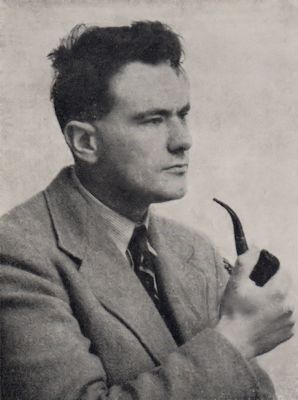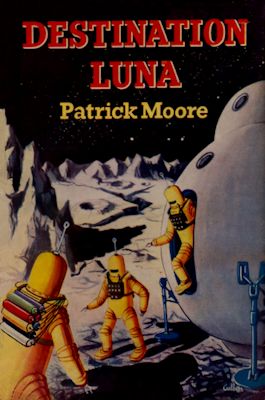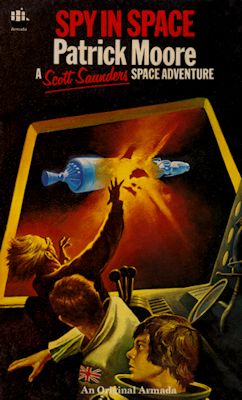Links to Bibliographies
The Big Three
--- Isaac Asimov
--- Arthur C. Clarke
--- Robert A. Heinlein
Patrick Moore
--- Introduction
--- Science Fiction
--- Miscellanea
Science Fiction and Fantasy Series
SF Universes and Fantasy Worlds
A Brief Biography of Sir Patrick Moore (1923-2012)
 |
| Patrick Moore, c.1954 |
He was president of the British Astronomical Association, co-founder and president of the Society for Popular Astronomy, author of over 70 books on astronomy, and presenter of The Sky at Night. As an astronomer, he became known as a specialist in Moon observation and he also compiled the Caldwell Catalogue of astronomical objects, a complement to the Messier Catalogue. In addition to many popular science books, he also wrote numerous works of science fiction.
Moore was also a self-taught xylophone player and pianist, as well as an accomplished composer. Idiosyncrasies such as his rapid diction and monocle made him a popular and instantly recognisable figure on British television. He believed himself to be the only person to have met the first aviator, Orville Wright, the first man in space, Yuri Gagarin, and the first man on the Moon, Neil Armstrong.
Patrick Alfred Caldwell-Moore was born in Pinner, Middlesex on 4 March 1923. His family moved to Bognor Regis, and subsequently to East Grinstead where he spent his childhood. His youth was marked by heart problems, which left him in poor health and to him being educated at home by private tutors. He developed an interest in astronomy at the age of six and joined the British Astronomical Association at the age of eleven. He was invited to run a small observatory in East Grinstead at the age of 14, after his mentor, who ran the observatory, was killed in a road accident. At the age of 16 he began wearing a monocle after he was told that his right eye was weaker than his left.
During World War II, Moore joined the Home Guard in East Grinstead where his father had been elected platoon commander. He enlisted in the Royal Air Force Volunteer Reserve in December 1941 at age 18 but was not called up for service until July 1942. After basic training he went to Canada under the British Commonwealth Air Training Plan and completed training at RAF Moncton in New Brunswick as a navigator and pilot. During his time in Canada, he met Albert Einstein and Orville Wright while on leave in New York. Returning to England in June 1944, he was posted to RAF Millom in Cumbria, where he was a navigator in the crew of a Vickers Wellington bomber, engaged in maritime patrolling and bombing missions to mainland Europe.
The war had a significant influence on his life, he said his only romance ended when his fiancée Lorna, a nurse, was killed in London in 1943 by a bomb which struck her ambulance. Moore subsequently remarked that he never married because "there was no one else for me ... second best is no good for me ... I would have liked a wife and family, but it was not to be."
After the war, Moore worked a teacher from 1945 to 1953, in Woking and at Holmewood House School in Langton Green. While at Holmewood he set up a 12½ inch reflector telescope at his home, which he kept into his old age. He developed a particular interest in the far side of the Moon, a small part of which is visible from Earth as a result of the Moon's libration. He claimed to have discovered and named the Mare Orientale (Eastern Sea) in 1946, along with H P Wilkins, though he later conceded that German astronomer Julius Heinrich Franz should be credited with the discovery. The feature had been observed several times since telescopic observations began. Moore described short-lived glowing areas on the lunar surface, and gave them the name transient lunar phenomena in 1968.
 Moore's first published book was The Planet Mars (1952), a translation of a work by French astronomer Gérard de Vaucouleurs. Also in 1952, his first fiction, The Master of the Moon, was published by Museum Press; the first of many science fiction adventures for young-adults. His first original non-fiction work, Guide to the Moon was issued by Eyre & Spottiswoode in 1953 and was followed by Guide to the Planets in 1954. Moore's output over the next decade amounted to over thirty volumes of fiction and non-fiction.
Moore's first published book was The Planet Mars (1952), a translation of a work by French astronomer Gérard de Vaucouleurs. Also in 1952, his first fiction, The Master of the Moon, was published by Museum Press; the first of many science fiction adventures for young-adults. His first original non-fiction work, Guide to the Moon was issued by Eyre & Spottiswoode in 1953 and was followed by Guide to the Planets in 1954. Moore's output over the next decade amounted to over thirty volumes of fiction and non-fiction.
His first television appearance was in a debate about the existence of flying saucers following a spate of reported sightings in the 1950s; Moore argued against Lord Dowding and other UFO proponents. He was invited to present a live astronomy programme and said the greatest difficulty was finding an appropriate theme tune; the opening of Jean Sibelius's Pelléas et Mélisande was chosen and used throughout the programme's existence. The programme was originally named Star Map before The Sky at Night was chosen in the Radio Times. On 24 April 1957, Moore presented the first episode about the Comet Arend–Roland. The programme was pitched to casual viewers up to professional astronomers, in a format which remained consistent from its inception.
Moore presented every monthly episode except for one in July 2004 when he suffered food poisoning and was replaced for that episode by Chris Lintott. From 2004, the programme was broadcast from Moore's home, when arthritis prevented him from travelling to the BBC studios in London. Over the years he received many lucrative offers to take his programme onto other networks, but rejected them because he held a 'gentlemen's agreement' with the BBC.
A highlight of the series in 1959 was when the Russians allowed Moore to be the first Westerner to see the photographic results of the Luna 3 probe, and to exhibit them live on air. Less successful was the transmission of the Luna 4 probe, which ran into technical difficulties and around this time Moore famously swallowed a large fly; both episodes were live and Moore had to continue regardless. He was invited to visit the Soviet Union, where he met Yuri Gagarin, the first man to journey into outer space. For the fiftieth episode of The Sky at Night, in September 1961, Moore's attempt to be the first to broadcast a live direct telescopic view of a planet resulted in another unintended 'comedy episode', as cloud obscured the sky.
In 1965, Moore was appointed director of the newly constructed Armagh Planetarium in Northern Ireland, a post he held until 1968. This led to a pause in his fiction writing as he dedicated himself to his new post. In developing the Planetarium, Moore travelled to Japan to secure a Goto Mars projector. In June 1968 he returned to England, settling in Selsey after resigning his post in Armagh due to the escalating Troubles and to his dislike of commuting by air to London to folm the The Sky at Night. He also helped with the redevelopment of the Birr Telescope in the Republic of Ireland and was a key figure in the development of the Herschel Museum of Astronomy in Bath.
 Moore was a presenter for the Apollo 9 and Apollo 10 missions, and a commenter for the BBC's coverage of the Moon landings. During the NASA Apollo programme, presenting on the Apollo 8 mission, he said that "this is one of the great moments of human history", only to have his broadcast interrupted by the children's programme Jackanory. During the 1970s and 80s he also reported on the Voyager and Pioneer programs, often from NASA headquarters.
Moore was a presenter for the Apollo 9 and Apollo 10 missions, and a commenter for the BBC's coverage of the Moon landings. During the NASA Apollo programme, presenting on the Apollo 8 mission, he said that "this is one of the great moments of human history", only to have his broadcast interrupted by the children's programme Jackanory. During the 1970s and 80s he also reported on the Voyager and Pioneer programs, often from NASA headquarters.
Between 1977 and 1980, Fontana Paperbacks published the six volumes of his Scott Saunders Space Adventure series under their Armada imprint, beginning with Spy in Space (the first science fiction book I ever read!) and ending with The Secret of the Black Hole; he also wrote a more adult novel and a farce titled Ancient Lights, though he did not wish either to be published.
In 1986 he was identified as the co-author of a book published in 1954 called Flying Saucer from Mars, attributed to Cedric Allingham, which was intended as a money-making venture and practical joke on UFO believers; Moore never admitted his involvement. He once joined the Flat Earth Society as an ironic joke.
Elected a Fellow of the Royal Astronomical Society in 1945, he was awarded the society's Jackson-Gwilt Medal in 1977. In 1968, he was appointed an Officer of the Order of the British Empire (OBE) and promoted to a Commander (CBE) of the order in 1988. In 2001, he was knighted for services to the popularisation of science and to broadcasting. That year he was also appointed an Honorary Fellow of the Royal Society, the only amateur astronomer ever to achieve the distinction. The following year, Buzz Aldrin presented him with a BAFTA award for services to television. Moore had a long association with the University of Leicester and its Department of Physics and Astronomy, and was awarded an honorary Doctor of Science in 1996 and a Distinguished Honorary Fellowship in 2008.
It was reported in January 2012 that because of arthritis and the effects of an old spinal injury Moore was no longer able to operate a telescope. However, he was still able to present The Sky at Night from his home. He appears in the Guinness World Records book as the world's longest-serving TV presenter having presented the programme from 1957 until his death.
On 9 December 2012, Patrick Moore died at his home in Selsey, West Sussex. He was 89.
References
- Wikipedia - Patrick Moore - retrieved 28 March 2016 - the text above is largely a revised version of the Wikipedia article
- The Internet Speculative Fiction Database - Patrick Moore - Summary Bibliography - retrieved 28 March 2016
- The Encyclopedia of Science Fiction - Patrick Moore - retrieved 28 March 2016
- Astronomy Now - Patrick Moore's Bibliography - retrieved 28 March 2016
A list of Patrick Moore's published fiction appears below.
An illustrated bibliography can be found here.



